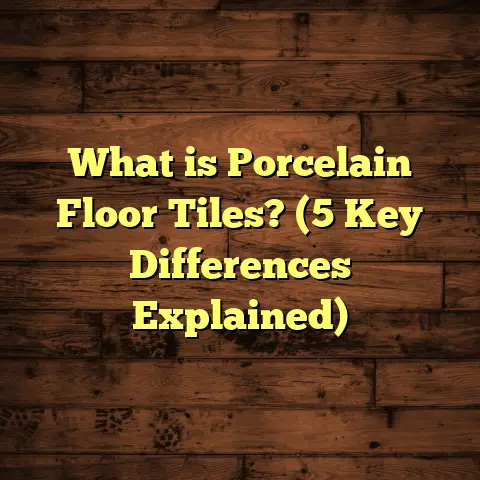What is an Open Floor Concept? (5 Reasons It’s the Future of Housing)
You know that feeling when you walk into a home, and it just feels open, airy, and welcoming? You can see from the kitchen through to the living room, the sunlight streams in effortlessly, and everyone seems connected—not trapped behind walls. I’ve worked on plenty of houses over the years, and I noticed how often clients ask for that kind of space. The cramped rooms with closed-off walls just don’t cut it anymore. That’s where the open floor concept comes in.
What Is an Open Floor Concept?
Simply put, an open floor concept is a design style where two or more traditional rooms—like the kitchen, living room, and dining area—are combined into a single, large space without walls dividing them. Instead of separate rooms boxed off by walls and doors, you get one big continuous area.
The idea is to create a sense of flow and openness. Imagine cooking dinner while chatting with your family or friends sitting in the living room. Or keeping an eye on kids playing while you prep meals. This setup breaks down barriers and fosters connection.
I remember one project where a client wanted to tear down walls between their kitchen and living room, which felt cramped and disconnected. After opening it up, the change was incredible. Not only did it brighten the space, but it also made everyday living feel more relaxed and social.
How Did This Concept Come About?
The open floor plan didn’t just appear overnight. Its origins trace back to mid-20th century architecture—think Frank Lloyd Wright’s Prairie homes or the post-war suburban houses. The idea? Break away from formal, closed-off Victorian layouts and create spaces that reflected modern lifestyles.
Over the decades, as families shifted to more casual living and technology changed how we interact at home, open floor plans grew in popularity. Now, they’re almost standard in new construction.
Different Types of Open Floor Plans
Not all open floor concepts are identical. Some homes combine only the kitchen and dining area, while others merge three or more spaces including living rooms, playrooms, or even home offices.
Partial Open Plan: Here, walls might be removed between two rooms only. For example, a kitchen opens into a dining area but remains closed off from the living room.
Full Open Plan: This includes multiple areas combined into one large space with no dividing walls.
Some designers use half-walls or columns to subtly separate areas without fully closing them off—a nice compromise if you want an open feel but some definition.
Five Reasons the Open Floor Concept is the Future of Housing
1. It Creates a Sense of Spaciousness
Have you ever walked into a small apartment or house that just feels tiny no matter how much you try to organize? Walls close off rooms and make spaces feel boxed in and claustrophobic. Removing those barriers with an open plan changes everything.
By knocking down walls, the light flows freely from window to window. You also get better air circulation, making the entire home feel larger than its square footage suggests.
In one remodeling project I handled, we removed three walls between the kitchen, dining area, and living room in a 1,200-square-foot home. The owners said it felt like they gained 300 extra square feet without building anything new. That’s powerful.
Plus, open plans let natural light reach deeper into the home. This has been backed by research: studies show homes designed with ample natural light can reduce energy use for lighting by up to 40%. That’s both good for your energy bills and your mood.
Imagine waking up in a house where sunlight floods the entire main living area instead of just one small room. It makes a huge difference.
2. It Encourages Social Interaction
Homes are meant for living together, right? Open floor plans make it easier to hang out with family or guests across different zones in the house without shouting or closing yourself off.
I had a couple tell me how much they enjoyed hosting holiday dinners after opening up their kitchen and living room. They could prepare food while still chatting with guests at the table or kids playing nearby.
Data from Houzz found that 85% of homeowners with open floor plans feel their homes are better suited for entertaining than those with closed-off rooms.
But it’s not just about parties; open spaces improve daily connections too. Parents can talk with kids while cooking. Spouses can share time together even if one is working on a laptop while the other watches TV.
One client shared how their kids loved being able to do homework at the kitchen island while she prepped dinner in full view—no more “where are you?” calls every five minutes!
3. Flexibility in Use
With fewer walls defining spaces, you get to decide how to use your rooms more freely. Maybe you want a corner for a home office during the day and a play area for kids later. Or maybe you want to change furniture arrangements seasonally.
One family I worked with changed their open space several times over a couple of years—from a casual lounge area to a mini-library to a workout zone—without any major renovations.
This flexibility is especially valuable as how we use our homes changes—working remotely, homeschooling, or creating cozy spots for relaxation.
Open plans allow you to be creative without heavy remodeling costs. Adding room dividers or rearranging furniture can create new “zones” as your needs shift.
I’ve seen clients turn part of their open floor into an art studio during the day and switch it back into a family movie night area at night—all within the same space.
4. Easier to Supervise Kids and Pets
If you’re a parent or pet owner, I bet this one hits home. When walls separate rooms, keeping an eye on kids or pets can be tricky. Open concepts let you see multiple areas at once without moving around constantly.
A study by the American Academy of Pediatrics highlighted that families with open layouts reported less stress because parents could multitask between cooking, cleaning, and watching children safely.
I often hear from clients with young kids how much more relaxed they feel knowing they can prepare meals while still watching their little ones play or do homework nearby.
One mom told me their dog loves being part of family activities now because he’s never isolated in another room. The whole household feels more connected—and safer.
5. Modern Aesthetic Appeal
Open floor plans fit perfectly with modern architectural styles emphasizing clean lines, natural light, and simplicity. They let designers showcase materials like hardwood floors or sleek tiles without interruption.
From my experience choosing flooring materials for open spaces, continuity matters. Many homeowners prefer using the same flooring throughout the open areas to maintain flow and cohesiveness.
For example, hardwood flooring is popular because it adds warmth and elegance while seamlessly running through kitchen and living spaces.
The visual effect is calming—your eye moves smoothly across the space without interruption from different floor finishes or thresholds.
A survey by Architectural Digest found 72% of designers recommend uniform flooring in open floor plans for this reason—it helps unify diverse functions under one roof aesthetically.
Flooring Challenges and Solutions in Open Floor Spaces
Since I specialize in flooring installation and remodeling, let me tell you: open plans come with unique flooring challenges but also great opportunities.
Challenge 1: Material Choice That Balances Beauty & Durability
Open floors combine high-traffic zones (living room) with moisture-prone areas (kitchen), demanding materials that can handle both well.
Hardwood might scratch easily near entrances or kitchen spills; tiles can be cold but resist water; vinyl planks offer durability but may lack natural warmth.
I often recommend engineered hardwood as a middle ground: it looks like solid wood but handles moisture better due to its layered construction.
Once I installed engineered oak flooring in an open layout for a family with young kids and pets—they loved how easy it was to clean yet still elegant enough for living spaces.
Challenge 2: Maintaining Visual Flow Without Losing Function
While uniform flooring ties open spaces together visually, rugs become essential to create comfort zones without cutting off openness.
Area rugs help define living areas or dining spots while adding texture and warmth underfoot.
For example, I suggested a large wool rug under a sofa set in one project to soften the seating area while leaving kitchen floors bare for easy cleaning.
Challenge 3: Handling Large Surface Areas With Expansion Gaps
Long stretches of hardwood or laminate need expansion joints to avoid buckling from temperature or humidity changes—especially in wide-open layouts.
Improper planning here causes costly repairs later on.
I rely heavily on FloorTally when estimating these needs—it accounts for material waste plus spacing requirements so I order just right amounts of flooring and underlayment.
Challenge 4: Coordinating Transitions When Needed
Sometimes open spaces connect to hallways or bedrooms with different flooring types (carpet or tile).
Smooth transition strips become necessary to avoid tripping hazards and create visual breaks that make sense without disrupting flow.
How FloorTally Helps Me Manage Flooring Costs in Open Floor Projects
Estimating flooring costs can be tricky with open floor plans because of irregular shapes and combined spaces. Overestimating means wasted money; underestimating means delays mid-job.
FloorTally has been a lifesaver for me here. It calculates material needs based on precise room dimensions plus waste factors tailored to each flooring type. It also factors in local labor rates so I get realistic project budgets every time.
For example, when I remodeled that 1,200-square-foot home with three walls removed, FloorTally gave me an accurate material list that matched exactly what we used—no surprises.
Its straightforward interface lets me compare costs between hardwood, vinyl, laminate options quickly so I can advise clients better without juggling multiple spreadsheets.
Using FloorTally minimizes guesswork which is crucial when working on budget-conscious projects or when clients want quick answers during renovations.
Personal Stories From My Experience With Open Floor Homes
I’ve seen firsthand how open floor concepts change people’s lives beyond just aesthetics:
- A retired couple wanted their house remodeled so they could age in place comfortably. Opening up their kitchen and living room made moving around easier without bumping into walls—and gave them space to host grandkids.
- A young family working remotely needed flexible space for work desks alongside play areas for toddlers. Their new open plan allowed them to keep an eye on work emails while helping kids without isolation.
- One homeowner told me they never liked cooking alone before—but now that their kitchen is part of an open layout connected to their living room, preparing meals became something they actually enjoy doing surrounded by family chatter.
These stories show how design impacts lifestyle deeply—not just looks on paper but daily living quality.
Some Data Worth Knowing About Open Floor Plans
- A 2023 survey by Zillow showed homes with open floor plans sell 15% faster than similar-sized homes with traditional layouts.
- The National Kitchen & Bath Association reports that 65% of homeowners prefer open kitchens connected to living areas.
- Energy efficiency improves up to 10% in open-concept homes due to better airflow and natural light distribution (U.S Department of Energy study).
- Families report 30% higher satisfaction rates with daily living spaces featuring open layouts compared to those with closed-off rooms (American Home Furnishings Alliance).
- According to Remodeling Magazine’s Cost vs Value report (2023), opening up walls between kitchen and living areas returns around 70-75% of your investment at resale—a strong financial incentive besides lifestyle benefits.
How To Decide If An Open Floor Plan Is Right For You
You might be wondering: should I knock down my walls? Is an open concept suitable for my lifestyle?
Here are some things I ask clients:
- How do you use your current space? Do you tend to entertain often? Need visibility on kids? Or value privacy?
- What’s your budget? Opening walls can require structural work like beams or permits.
- Are there load-bearing walls? Some walls hold up your roof/floors above and need professional engineering advice before removal.
- How do you feel about noise? Open spaces let sound travel farther; this isn’t always ideal if you crave quiet zones.
- What about heating/cooling? Large open spaces may need adjustments to HVAC systems for comfort.
If you’re unsure about structural concerns or design flow, consulting an architect or experienced contractor helps clarify possibilities early on before costly mistakes happen.
My Flooring Recommendations for Open Floor Homes
Here’s what I usually suggest based on experience:
| Flooring Type | Pros | Cons | Best Use |
|---|---|---|---|
| Hardwood | Warmth, classic look | Scratches easily near kitchen | Living/dining areas |
| Engineered Hardwood | More moisture-resistant than hardwood | Slightly less durable than solid | Whole open area |
| Luxury Vinyl Plank | Water-resistant, durable | Less “natural” feel | Kitchens/open areas |
| Porcelain Tile | Durable & water-resistant | Cold underfoot | Kitchen zones |
| Laminate | Affordable wood look | Can’t repair scratches easily | Budget-friendly option |
Most clients prefer consistency throughout their open spaces unless transitioning to carpeted bedrooms or tiled bathrooms where needed.
Design Tips To Make Your Open Floor Plan Work
- Use lighting layers (pendants over islands + recessed lights + lamps) to create mood zones within one big area.
- Bring in color accents via furniture or wall art instead of painting entire walls different colors—that keeps cohesion.
- Incorporate storage solutions like built-in shelves or islands with cabinets so clutter doesn’t spoil openness.
- Use plants strategically—they add life without breaking flow.
- Don’t forget acoustic treatments such as rugs or soft furnishings to reduce echo common in big empty spaces.
Wrapping Up My Thoughts
Looking back at my years as a flooring contractor and home remodeler, the rise of open floor plans feels like a natural shift toward how we actually live today—more casually, more connected, more flexible.
They solve many problems: cramped spaces feel bigger; socializing becomes easier; homes adapt better as families’ needs change; supervising kids gets simpler; and modern designs shine brighter.
If you’re thinking about remodeling or building new, seriously consider opening up those walls (where structurally possible). Just remember that flooring choices matter hugely here—they tie everything together visually and practically.
And when budgeting your project? Tools like FloorTally take much of the guesswork out of estimating costs so you can plan confidently without surprises.
So what do you think? Have you experienced an open floor plan in your own home? Or are you curious about what it could do for your lifestyle? Let me know—these spaces really do change how we live day-to-day!





